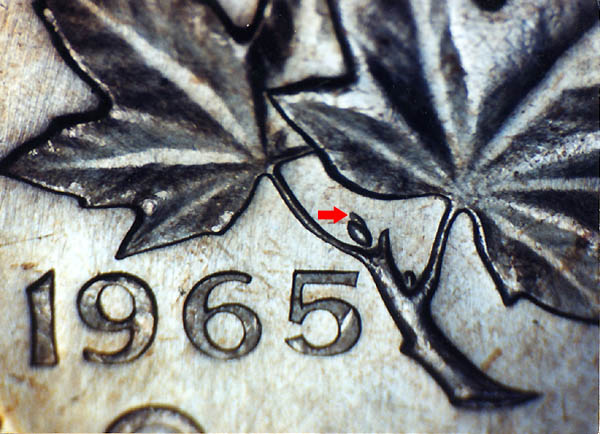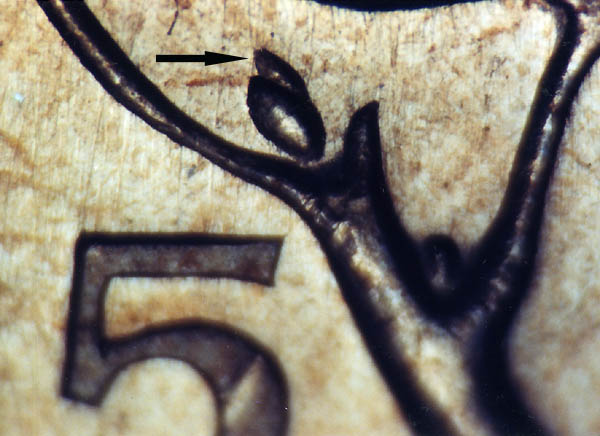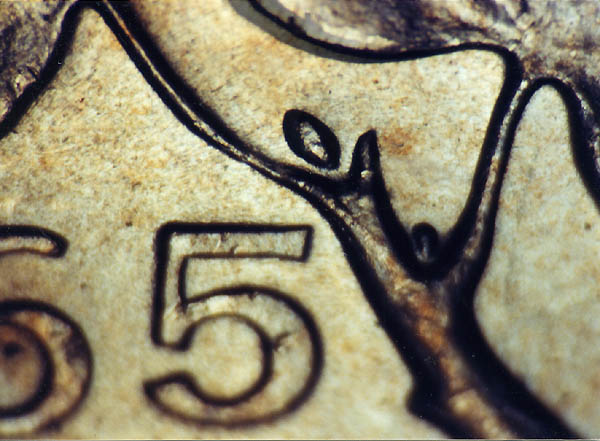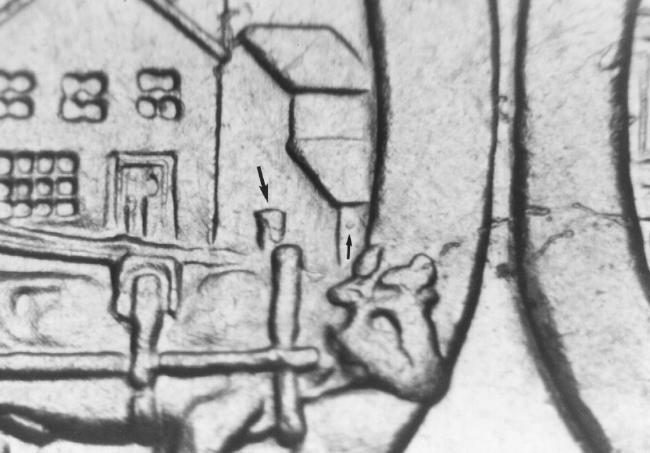|
|
Canada 1965
"Extra Bud" Doubled Die Cent
by Ken Potter - NLG
Originally presented in Canadian Coin
News 2006 - slight revisions have been made to update the text

A look at the Extra Bud Variety.

Here is an extreme enlargement of the Extra Bud Variety.

Here is the normal bud variety
A doubled die reverse for the 1965 Canadian one-cent piece has been discovered by Ken Hymer of Kansas. It is so unusual that most folks probably would have missed it even if they were looking specifically for doubled dies. Yet it is right there easy to spot by anybody using low magnification and who knows where to look. The variety is of the type of doubled die that is restricted to the virtual dead center of the design much like several doubled dies known for the reverse of the 1974 Winnipeg nickel dollars. In this case the doubling is evident as an "extra bud" found within the Maple Leaf sprig motif. The design normally exhibits two buds, including a fairly obvious bud where the stem of the left leaf attaches to the branch and a smaller less obvious bud in the same location relative to the right leaf. On Hymerís doubled die the larger bud to the upper left is joined by a second virtual clone of itself jutting out from underneath as an underlying image to the northeast!
Some will argue that it represents little more than a convenient die break or die chip but microscopic examination of the variety confirms that it is an unquestionable, provable hub doubled die. There are several diagnostics that allowed me to make this call.
The "extra bud" has the perfect shape that one would expect from an early hubbing of a design that would not be fully formed up from the first pass of the hub. It exhibits surface diagnostics consistent with an image that is not fully formed from an early pass. Such images often show some porosity or roughness to the surface texture due to not being hubbed up completely. Even more important, the primary bud, normal to the design shows a tiny flaw in its tip as a small "V" shaped split. That defect shows up on all coins of the date and type that I have examined that were of an early enough die state for it to still be present (I spot checked approximately 30 pieces out of three rolls of regular 1965 cents that I had on hand). This proves it is a diagnostic inherent to the hub and that this defect was passed on to many if not all the working dies (dies that actually strike the coins) for that year. This tiny microscopic split is repeated in the exact location at the tip of the underlying doubled bud! While microscopic, it is the clincher that along with the other evidence, proves that this is without question a doubled bud created from a misalignment in the hubbing process. (A hub is master tool with the design raised as on the coin and used to make dies; it is also known in some Mints [including the RCM] as a punch and in others as a hob).
Restrictive doubling such as this is a concept that less advanced error-variety specialists are often unaware of and as such is not well understood and often miss-diagnosed by the uninitiated. In fact, many collectors believe that to be a hub doubled die a coin must boast widespread doubling affecting much or all of a coin design. Nothing could be further from the truth. It is a well-known fact amongst the advanced specialists that hub doubling can be restricted to just one small area of the die due to what is referred to as "limited pressure hub doubling." Doubling that it limited to the virtual dead center of a design is possible due to the configuration of the die blank. To facilitate even flow of metal during hubbing a die blank is machined with a slightly conical shape to its face. Because of this shape the hub will always make contact with the very tip of the cone-shaped area of the die blank first. This, of course, represents what will eventually be the virtual dead center of the dieís design.

Here's a look at one of several doubled die varieties known on
the Canadian 1974 nickel dollar.
Collectors of Canadian coins may be familiar with the 1974 nickel dollar variety with the "extra yoke" above the ox as Variety-2 (a business strike that is shown here) was included in the Charlton Standard Catalogue to Canadian Coins starting in 1996 along with others in later years. (A total of 13 related 1974 dollar varieties were featured in the 2005, 59th edition). Our newly discovered 1965 Canada cent is reminiscent of these 1974 dollar variety discoveries. With doubling restricted to such a small area, (primarily in the center region above the ox's back), I mistakenly miss-attributed the 1974 varieties in early articles (back in the early 1980s) as intentional engraving varieties.
However, in 1983, Former Royal Canadian Mint, Master Engraver, Walter Ott examined an example of Reverse Die #1 (which is listed in Charlton under the Six coin Nickel Brilliant Uncirculated Sets 1968 -1976 category) and explained the occurrence as being the result of a hubbing accident.
According to Ott, because a die blank starts out with a cone shaped face, (rather than flat as often presumed by collectors), it is possible to create doubling that is restricted to the center of the die if the hub is eased down and only kisses the tip of the cone. Ott suspected that the die blank was set into a hubbing press at a tilt. According to Ott, as the hubbing press operator eased down the hub (known as a "punch" in Canada) with the hydraulic press, the tilt was noticed just as the hub started to impress its image into the cone shaped tip. The hub was then backed off and the die blank reset into proper position. Impression(s) to follow were off register with the first impression and thus the resultant doubled die. In a later phone interview Ott noted that the same or similar effect could have occurred if the die/hub was tilted and forced into proper position by the pressure of the hubbing. This meant that the doubling could have occurred within one pass of the hub unnoticed to the hubbing press operator other than perhaps a tell-tale clunk of the die and hub as they seated themselves into proper position. It should be pointed out that it could have been the hub that was tilted and not the die. The effect would have been identical. Ottís explanation was revealing and helped to understand future finds of hub doubling of a similar nature on other coins.
This new 1965 cent doubled die has been entered into the Variety Coin Register as Canada 1965 1c Variety-2 (Small Beads - Blunt 5) VCR#1/DDR#1. Hymer found approximately 275 to 300 of them while searching through a $50 face value bag of the cents in 1998. The variety is found in combination with the blunt 5 of date reverse and is mated to an obverse with small beads about the rim.
The coinage of 1965 is well-known for varieties. Almost upon their release, the one cent coin and silver dollars were heavily promoted when it was discovered they contained obverse and reverse variations in design. The cents contained both small and large bead obverse varieties while the reverses contained what were to become known as Pointed 5 and Blunt 5 varieties for the date. The die combinations were mixed resulting in four distinct varieties. The scarcest of these varieties is the Large Beads/Pointed 5 which is listed in Charlton at $100.00 CND in MS64 and $225.00 in MS65.
The dollars boasted very similar variations of small and large bead and pointed and blunt 5's in all combinations possible plus the addition of a medium beads variety paired with Pointed 5 reverse. This resulted in a total of five variety combinations for the dollar. The rarest of these varieties is the Medium Beads/Pointed 5, which is quoted at $200.00 in MS64. Charlton also lists a Small Beads/Blunt 5 dollar stuck in coin alignment (180 degree rotated reverse) at $3,000.00 for MS60.
A very rare 1965 five-cent variety was discovered to exist within the last decade which is designated by Charlton as Large Beads/Detached Jewel and it is quoted at $1500.00 in MS63 (it is also know in earlier die states with a barely attached jewel).
What the future popularity of a doubled die for this date will be is anybodyís guess!
Ken Potter is the official attributer of world doubled dies for the Combined Organizations of Numismatic Error Collectors of America and for the National Collectors Association of Die Doubling. He also privately lists other collectable variety types on both U.S. and world coins in the Variety Coin Register. More information on either of the clubs or how to get a coin listed in the Variety Coin Register may be obtained by sending a long self addressed envelope with $1.00 US postage (or currency) to P.O. Box 33, Pinckney, MI 48169 or by contacting him via email at KPotter256@aol.com. An educational image gallery may be viewed on his web site at www.koinpro.tripod.com
For more information on this item click below:
Send email to: KPotter256@aol.com

Numismatist Since 1959 ~ Serving
the Collector Since 1973
CONECA's Longest Serving Doubled Die Attributer
Member of: ANA-LM CONECA-LM NLG NCADD-FM
MSNS-LM
NWDCC RCC WBCC BBCC IASAC